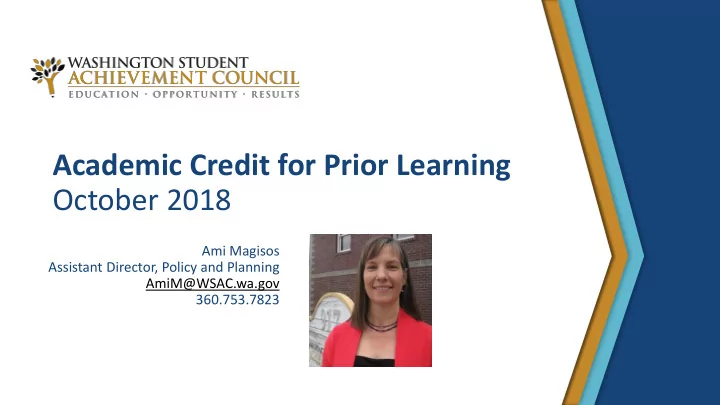

Academic Credit for Prior Learning October 2018 Ami Magisos Assistant Director, Policy and Planning AmiM@WSAC.wa.gov 360.753.7823
2 Agenda • Background: What is ACPL? Why is it important? • Accomplishments • ACPL in 2017-2018 • Discussion: What would you like to see in the coming years? • Washington information • Training and support • Other recommendations • Washington Adult Reengagement Initiative • What is it? • Summit 11/28
3 Definitions Prior learning is the knowledge and skills gained through: • Work and life experience. • Military training and experience. • Formal and informal education and training. Assessments are used to determine if the prior learning is at college level: Category Examples Credits by testing CLEP, DSST Extra-institutional learning ACE recommendations, industry certifications, crosswalks Course challenges Written, oral or demonstration Prior Experiential learning Portfolio
4 Awarding Credit • Outcomes are assessed and found to be equivalent to specific college course outcomes. • Awarding credit is consistent with the policies of the institution. Limitations, portability and transparency: • Prior experiential learning is limited to 25 percent of credits needed for a credential. • Noted on college transcripts as PEL . • Community and technical colleges ensure transferability of ACPL credits between them.
ACPL and Adult Reengagement Help make college more affordable, reducing cost and time to degree Inspire confidence in future learning Adult Adult potential Reengagement Reengage ment Launch students more quickly into their chosen career pathways 5
6 Legislative Action • 2010: SB6357 • 2011 • ACPL work group • Goals • Annual progress report • 2014 • Military training policies • List of military training and programs that qualify for academic credit
7 100% 70% High school diploma or Postsecondary equivalent credential 90% 52% Washington population ages 25-44 Source: 2017 WSAC Roadmap Progress Report
8 Highlights of ACPL Work • Workgroup members have been collaborative and engaged. • Data collection: • Full participation last year (50 institutions) • Last year, increase in credits awarded: 41 percent. • ACPL handbook and annual workshops: • Sample policies created. • Examples of assessments provided. • WSAC webpage on ACPL
9 2017-2018 Data (80% Reporting) Category Program Total Total Students Quarter Credits Credit by Testing DANTES Subject Standardized Tests (DSST) 17 190.5 College Level Exam Program (CLEP) 268 3,461.5 Prior Portfolio Review (college level credits) 173 1,805 Experiential Learning Extra- American Council of Education (ACE) (military 804 19,749.5 Institutional training and education) Learning Occupational Crosswalks (Military MOS, other) 500 14,689 Individual Industry Cert (e.g. NCLEX-RN) 485 11,320 Course Credit by Exam (generally a faculty or department- 350 2,527 Challenges created course-specific assessment) Totals students 2,597 53,742.5 and credits
10 Recommended Actions 2016-2017 1. Streamline data collection process. 2. Develop more consistent acceptance of American Council on Education (ACE) guide military recommendations. 3. Increase adoption of crosswalks between industry training and certifications and college courses. 4. Explore opportunities to develop education or learning modules to fill gaps between existing industry or military training and college courses. 5. Conduct further analysis of enrollment of veterans, and academic credit for military training. 6. Continue to convene the ACPL work group on a regular basis.
11 Discussion on Developing ACPL ACPL work group and learning opportunities: 1. Additional recommendations? 1. Training or professional development?
12 100% 70% High school diploma or Postsecondary equivalent credential 90% 52% Washington population ages 25-44 Source: 2017 WSAC Roadmap Progress Report
13 Key Challenge Areas Toward Long-term Goals • Remove system barriers for underserved students Close Opportunity Gaps • Provide support for underrepresented students • Address regional workforce shortages Support Regional Leaders • Engage and support communities • Recruit and support adult learners Reconnect Adult Learners • Target former students with credits Provide Affordable • Provide multiple high-quality pathways High-Quality Pathways • Address financing and affordability gaps
Washington Adult Reengagement Initiative Provide information and support to recruit, retain, and graduate adults who have not completed a credential. Target Washington residents who have earned college credit without completing a credential. 14
15 Adult Reengagement Summit & Pave the Way This year’s Pave the Way Conference : November 29 University of Washington, Seattle Husky Union Building 28
WSAC’s ACPL webpages: https://www.wsac.wa.gov/assessments-prior- learning Ami Magisos Assistant Director, Policy and Planning AmiM@wsac.wa.gov 360-753-7823
Recommend
More recommend